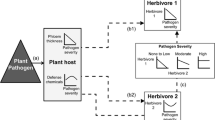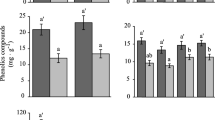Abstract
The parasitic dwarf mistletoeArceuthobium vaginatum attacksPinus ponderosa as its primary host andP. contorta as an occasional host. Within ponderosa pine stands there is also differential parasitism among individual trees. We compared biochemical features of phloem and xylem oleoresin between infected individuals of the two pine species (N=15 for each species) and also between infected (N=30) and nearby uninfected (N=30) ponderosa pine conspecifics. There were significant differences in chemical features, both at the interspecific (P. ponderosa vs.P. contorta) and intraspecific (P. ponderosa) levels. Discriminant function analysis based on chemical features of phloem correctly classified all trees used in the analysis as eitherP. ponderosa orP. contorta, and 95% of all ponderosa pine trees as either parasitized or nonparasitized. Monoterpene composition of oleoresin was distinct between species, and differences between parasitized and nonparasitizedP. ponderosa were also significant. Many of the observed chemical differences are probably constitutive, although levels of nonstructural carbohydrates and α-pinene may change in response to dwarf mistletoe infection. Biochemical differences at the intraspecific level were distinct from interspecific differences. Patterns of differential attack can have genetic consequences upon both the parasite and its hosts, and, in the process, may contribute to the evolution of host races of the parasite and to the evolution of host resistance within ponderosa pine.
Similar content being viewed by others
References
Clark, R.B. 1983. Plant genotype differences in the uptake, translocation, accumulation and use of mineral elements required for plant growth.Plant Soil 72:175–195.
Critchfield, W.B., andLittle, E.L., Jr. 1966. Geographic distribution of the pines of the world. US Department of Agriculture Forest Service Miscellaneous Publication 991. Washington, D.C.
Denno, R.F., andMcClure, M.S. (eds.). 1983. Viable Plants and Herbivores in Natural and Managed Systems. Academic Press, New York.
Fritz, R.S., andSimms, E.L. 1992. Plant resistance to herbivores and parasites. University of Chicago Press, Chicago, Illinois.
Hawskworth, F.G., andJohnson, D.W. 1989. Biology and management of dwarf mistletoe in lodgepole pine in the Rocky Mountains, USDA Forest Services General Technical Report RM 169.
Hawksworth, F.G., andWiens, D. 1972. Biology and classification of dwarf mistletoes (Arceuthobium). USDA Forest Service Agriculture Handbook 401.
Hodge, J.E., andHofreiter, B.T. 1962. Determination of reducing sugars, pp. 380–394,in R.L. Whistler and M.L. Wolfron (eds.). Methods of Carbohydrate Chemistry Volume I: Analysis and Preparation of Sugars. Academic Press, New York.
Lieutier, F., Cheniclet, C., andGarcia, J. 1989. Comparisons of the defense reactions ofPinus pinaster andPinus sylvestris to attacks of two bark beetles (Coleoptera; Scolytidae) and their associated fungi.Environ Entomol. 18:228–234.
Linhart, Y.B. 1989. Interactions between genetic and ecological patchiness in forest trees and their dependent species, pp. 393–430.in J.H. Bock and Y.B. Linhart (eds.) Evolutionary Ecology of Plants. Westview Press, Boulder, Colorado.
Linhart, Y.B., Snyder, M.A., andGibson, P. 1994. Differential host utilization by two parasites in a population of ponderosa pine.Oecologia 98:117–120.
Linhart, Y.B., Malville, L., Karron, J.D., andGehring, J.L. 1996. Genetic differentiation in the dwarf mistletoesArceuthobium vaginatum andA. americanum on their primary and secondary hosts.Silvae Genet. In press.
Livingston, W.H., Brenner, M.L., andBlanchette, R.A. 1984. Altered concentration of abscisic acid, indole-3-acetic acid, and zeatin riboside associated with castern dwarf-mistletoe infections on blue spruce,in Biology of Dwarf-mistletoe, USDA Forest Service General Technical Report RM-111.
MacLean, J.A., andEl Kassaby, Y.A. 1986. Elemental profiles for Douglas-fir seeds: Evidence of genetic control.Can. J. For. Res. 16:650–654.
Marpeau, A., Walter, J., Launay, J., Charon, J., Baradat, P., andGleizes, M. 1989. Effects of wounds on the terpene content of twigs of maritime pine II.Trees 4:220–226.
Nickrent, D.L., andStell, A.L. 1990. Electrophoretic evidence for genetic differentiation in two host races of hemlock dwarf-mistletoe (Arceuthobium tsugense).Biochem. Syst. Ecol. 18:267–275.
Roth, L.F. 1974. Resistance of ponderosa pine to dwarf-mistletoe.Silvae Genet. 23:116–119.
Roy, J. 1982. Intra-specific variation in the physiological characteristics of perennial grasses of the Mediterranean region.Ecol. Medit. 8:435–448.
Scharpf, R.F., andParmeter, J.R. 1978. Proceedings of the symposium on dwarf-mistletoe control through forest management. USDA Forest Service General Technical Report PSW-31. Berkeley, California.
Scharpf, R.F., Kinlock, B.B., andJenkinson, J.L. 1992. One seed source of Jeffrey pine shows resistance to dwarf-mistletoe. USDA Forest Service Research Paper PSW RP.207.
Smith, R.H. 1977. Monoterpenes of ponderosa pine xylem resin in western United States. USDA Forest Service General Technical Bulletin 1532.
Snyder, M.A. 1992. Selective herbivory by Abert's squirrel mediated by chemical variability in ponderosa pine.Ecology 73:1730–1741.
Snyder, M.A. 1993. Interactions between Abert's squirrel and ponderosa pine: The relationship between selective herbivory and host plant fitness.Am. Nat. 141:866–879.
Snyder, M.A., andLinhart, Y.B. 1994. Nest-site selection by Abert's squirrel: Chemical characteristics of nest trees.J. Mammal. 75:136–141.
Squillace, A.E. 1971. Inheritance of monoterpene composition in cortical oleoresin of slash pine.For. Sci. 17:381–387.
Vernet, P., Gouyon, P.H., andValdeyron, G. 1986. Genetic control of the oil content inThymus vulgaris L.: A case of polymorphism in a biosynthetic chain.Genetica 69:227–231.
Author information
Authors and Affiliations
Rights and permissions
About this article
Cite this article
Snyder, M.A., Fineschi, B., Linhart, Y.B. et al. Multivariate discrimination of host use by dwarf mistletoeArceuthobium vaginatum subsp.cryptopodum: Inter- and intraspecific comparisons. J Chem Ecol 22, 295–305 (1996). https://doi.org/10.1007/BF02055100
Received:
Accepted:
Issue Date:
DOI: https://doi.org/10.1007/BF02055100




